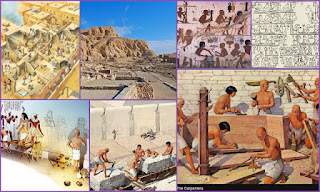Labor Day in Ancient Egypt
Labor Day is a holiday in the United States, and one most of us look forward to celebrating. (Who doesn't like a day off work?) This link is to a post I did last for Labor Day 2015; to be perfectly honest, not that much changed in ancient Egyptian labor practices since last year.
The Egyptian Museum of Barcelona
The Egyptian Museum Barcelonaopened in 1994 to display the Egyptian collection of Jordi Clos and introduce the public to 1,100 Egyptian artefacts and various temporary exhibitions. It forms part of the Clos Archaeological Foundation, which also funds archaeological expeditions and training.
The museum is served by the efficient Barcelona metro and easily found between Gaudi’s Sagrada Familia masterpiece and the Passeig De Catalunya, where many other modernist buildings are located. The museum is clean, tidy and well lit and the exhibits are displayed across three floors.
Formwerk3D helps 3D scan rare bust of Ancient Egyptian pharaoh Akhenaten
Up until now, if you wanted to see the rare Ancient Egyptian bust of Akhenaten you would have had to bustle through a crowd at Hannover’s Museum August Kestner and peer past a casing of protective glass. Now, thanks to 3D scanning technologies, you don’t even have to make the trip to Germany to see the stunning artwork.
The Pharaoh’s Magic – Imagery and Diplomacy in the Late Bronze Age
Today we imagine Egyptian magic through the lenses of the Bible and films. But what was the ‘actual’ role of ancient Egyptian magic in the royal palace when the king received foreign delegations?
Imagine you are an upper class Hittite. In your own country you serve your king and live a comfortable life in a spacious estate surrounded by many exotic luxury goods. You have the respect of your peers and command the service of the rest of the population. As a friend of the king of Hatti you are also well-versed in foreign politics, and so you are assigned to visit the king of Egypt and deliver gifts.
A Royal Children’s tomb discovered in the West Bank’s Valley of the Kings in Luxor
By I, Nikater, CC BY-SA 3.0, https://commons.wikimedia.org/w/index.php?curid=2635512
According to Dr. Abdel Hakim Karrar, Archaeologist in Egypt, the excavations carried out by the Swiss archaeological delegation of the University of Basel in the Valley of the Kings in Luxor’s West Bank have uncovered several rooms inside tomb KV.40 that were apparently used by the children of the royal family, specifically sons of the Kings Thutmose IV and Amenhotep III (1400-1350 B.C.)







No comments:
Post a Comment
Note: Only a member of this blog may post a comment.